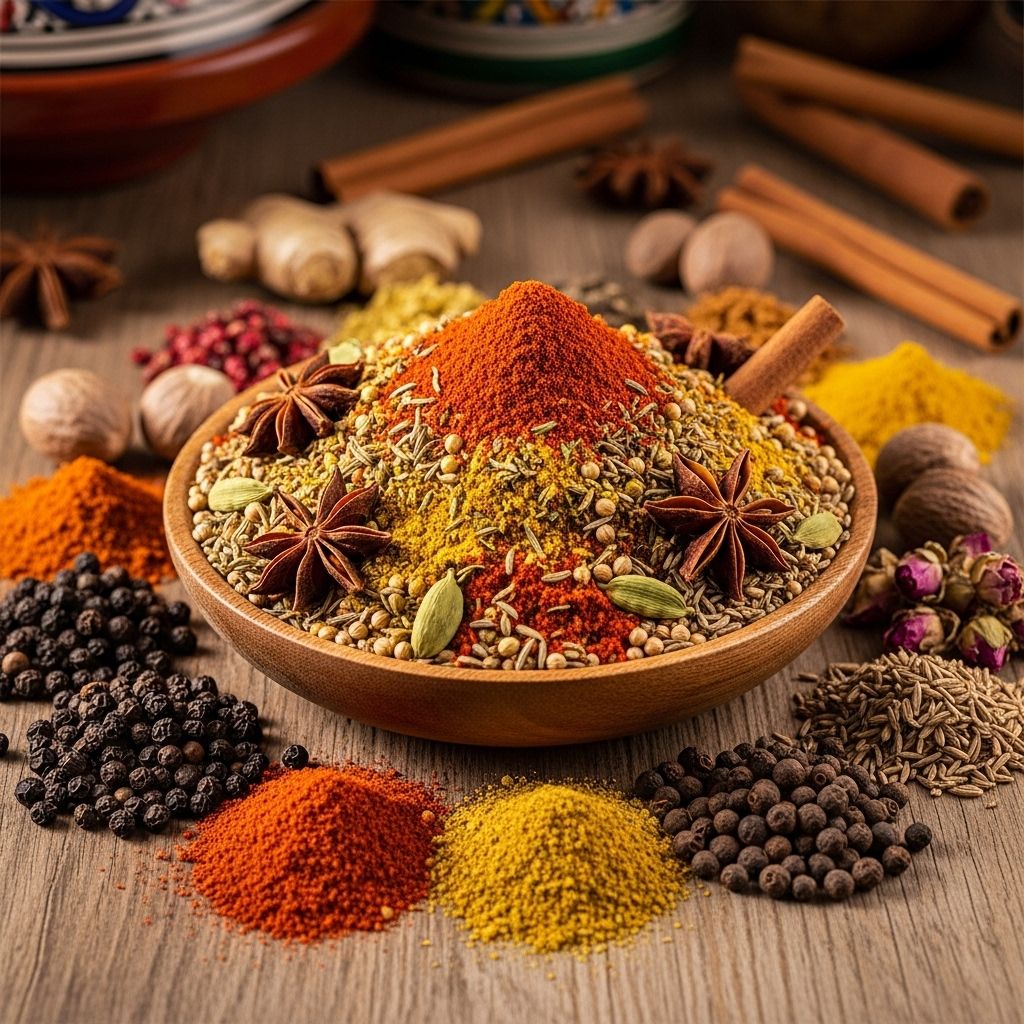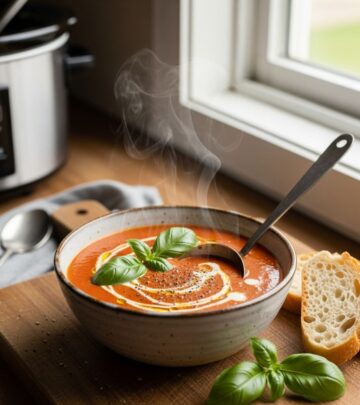Ras el Hanout: The Quintessential Moroccan Spice Blend
Discover the history, uses, and recipes of Ras el Hanout—the complex Moroccan spice blend that transforms any dish.

Ras el Hanout: The Signature Spice Blend of North Africa
Ras el Hanout is one of the most renowned and complex spice blends in North African cuisine, especially in Morocco, Tunisia, and Algeria. The name, translating to “the head of the shop” in Arabic, signifies the finest selection of spices a merchant offers—an aromatic symphony that reflects centuries of culinary history and regional diversity.
What is Ras el Hanout?
Ras el Hanout represents not just a distinctive mix of flavors, but also a concept: every blend should be unique, crafted as the merchant’s or family’s pride. There is no singular recipe; instead, each version is a permutation of North Africa’s most prized and fragrant spices—often more than a dozen, sometimes dozens more. This variability is what makes Ras el Hanout so fascinating in the culinary world.
- Origin: Morocco, but widely used in Tunisia and Algeria as well.
- Typical uses: Tagines, couscous, grilled meats, vegetables, soups, and rice dishes.
- Flavor profile: Warm, earthy, floral, sometimes subtly sweet and spicy depending on the ingredients.
History and Cultural Significance
The tradition of Ras el Hanout has deep roots in Maghrebi markets. Spice merchants often guarded their blends with secrecy, and even within households, family recipes could vary. In fact, it was common for families to compete, each believing their Ras el Hanout stood above the rest. Over time, the blend became a symbol of culinary creativity and pride, featuring in both festive banquets and everyday meals.
Core Characteristics
- Complexity: Can include a dozen to over 50 spices.
- Uniqueness: No two blends are identical; each is a signature of its creator.
- Tradition: Associated with the very best the spice merchant has to offer.
- Versatility: Suitable for meat, fish, vegetable, and grain dishes.
Common Ingredients Found in Ras el Hanout
Though the exact mix differs, certain core spices appear in most Ras el Hanout blends. The resulting bouquet is aromatic, complex, and evocative of North African marketplaces.
- Cardamom
- Coriander seeds
- Cumin
- Cinnamon
- Clove
- Black and white peppercorns
- Nutmeg
- Allspice
- Ginger (dried or ground)
- Turmeric
- Paprika (sweet and/or hot)
- Mace
- Anise seed or fennel
- Chili peppers or cayenne (for heat)
- Rose petals (dried, for floral notes)
- Saffron (for luxury and color, optional)
- Others: bay leaves, galangal root, long pepper, nigella seeds, orris root, grains of paradise (in rarer or more elaborate blends).
Traditional blends rarely include salt or sugar, and while some modern commercial versions add dried garlic or onion, this is typically not traditional.
Ingredient Table: Popular Ras el Hanout Spices
| Spice | Flavor Profile | Traditional? |
|---|---|---|
| Coriander | Earthy, citrusy | Yes |
| Cumin | Nutty, warm | Yes |
| Cinnamon | Sweet, woody | Yes |
| Cardamom | Pungent, sweet | Yes |
| Clove | Warm, pungent | Yes |
| Paprika | Sweet, mild heat | Yes |
| Ginger | Peppery, sweet | Yes |
| Nutmeg | Warm, nutty | Yes |
| Mace | Delicate nutmeg | Common |
| Rose petals | Floral | Optional |
| Saffron | Earthy, luxurious | Optional |
| Black pepper | Pungent | Yes |
| Cayenne/Chili | Hot, pungent | Optional |
How to Make Ras el Hanout at Home
Making Ras el Hanout from scratch ensures a vibrant, aromatic result—far superior to most store-bought blends. There are two basic methods:
Using Whole Spices
- Lightly toast your whole spices (such as coriander seeds, cumin, peppercorns, cardamom pods, etc.) in a dry skillet until fragrant.
- Let them cool, then grind in a spice grinder or with a mortar and pestle.
- Add ground spices such as turmeric, nutmeg, and cinnamon, along with any optional floral or exotic ingredients like dried rose petals or saffron.
- Whisk together and store in an airtight glass jar, away from direct sunlight.
Quick & Convenient Version - Directly combine high-quality ground spices in the proportions you prefer.
- Store in an airtight container for up to 6 months for best flavor.
Whether using whole or ground spices, freshness is key to capturing the blend’s complexity.
Classic Ras el Hanout Recipe
Adapt this recipe to your taste and the availability of spices. For many cooks, experimentation is part of the experience.
- 2 teaspoons ground coriander
- 2 teaspoons ground cumin
- 2 teaspoons ground nutmeg
- 1 teaspoon ground ginger
- 1 teaspoon ground allspice
- 1 teaspoon ground cinnamon
- 1 teaspoon paprika (sweet or hot)
- 1 teaspoon ground black pepper
- ½ teaspoon turmeric
- ½ teaspoon cayenne
- ½ teaspoon cloves
- Optional: ½ teaspoon crumbled dried rose petals, a pinch of saffron, a pinch of ground mace, or grains of paradise.
Mix all ingredients thoroughly and store in a dry, airtight container.
Tips for Customizing Your Blend
- Add floral notes by incorporating dried rose petals, lavender, or saffron for an authentic Moroccan touch.
- If you prefer mild heat, use just a pinch of cayenne or skip it altogether.
- For a deeper, more savory blend, emphasize cumin, coriander, and ginger.
- Sweet-and-spicy vibes can be achieved with extra cinnamon and allspice.
- Toast whole spices before grinding to intensify aromatics and flavor.
- Omit rare ingredients (like orris root or grains of paradise) if unavailable—the blend is highly forgiving.
How to Store Ras el Hanout
- Store in an airtight container, preferably glass, in a cool, dark place.
- Shelf life: Most flavorful within 3-6 months, though it can last up to a year. If the aroma fades, warm gently in a skillet to revive.
Culinary Uses: How to Cook with Ras el Hanout
Ras el Hanout infuses dishes with a depth that comes from its layered aromas and flavors. Here are popular ways to use it in everyday and festive cooking:
- Tagines: Essential in Moroccan tagines of lamb, beef, chicken, or vegetables, where the spices meld with rich sauces over slow heat.
- Couscous: A pinch stirred into couscous or rice brings instant North African flair.
- Meat rub: Massage onto chicken, lamb, beef, or fish before grilling or roasting for robust flavor and golden color.
- Roasted vegetables: Toss root vegetables or potatoes in olive oil and Ras el Hanout before roasting.
- Soups & stews: Add to hearty soups, lentil stews, or tomato-based dishes for added depth.
- Marinades: Blend with olive oil, garlic, and lemon for a flavorful marinade.
- Egg dishes: Sprinkle on scrambled eggs, omelets, or traditional shakshuka.
Ras el Hanout Variations
Regional and household differences mean no two Ras el Hanout blends are the same. Here are some examples of what you might encounter:
- Moroccan Ras el Hanout: Often floral, sometimes including dried rosebuds or lavender.
- Algerian Ras el Hanout: May use more chili and pepper for a spicier blend.
- Tunisian Ras el Hanout: Leans toward pungent, earthy, and slightly hot characteristics.
Some traditional Moroccan recipes reportedly included exotic spices and even dubious ingredients like cantharides (blister beetles), now safely omitted by all reputable spice merchants.
Ras el Hanout vs. Other Spice Blends
| Spice Blend | Region | Key Ingredients | Typical Uses |
|---|---|---|---|
| Ras el Hanout | Morocco, North Africa | Wide mix: cumin, coriander, cinnamon, cardamom, etc. | Tagines, couscous, rubs |
| Baharat | Middle East | Black pepper, coriander, cinnamon, cloves, cardamom, nutmeg | Meats, grains, soups |
| Garam Masala | India | Coriander, cumin, cardamom, cinnamon, cloves, nutmeg, pepper | Curry bases, finishing, masalas |
| Advieh | Persia/Iran | Cinnamon, cardamom, cumin, rose petals | Rice, meats, stews |
Buying Ras el Hanout
Ras el Hanout is available in specialty spice shops, Middle Eastern groceries, well-stocked supermarkets, and online stores. Store-bought blends range from simple to elaborate, and ingredients may differ, with some using added salt, garlic, or herbs. Check labels for authenticity and freshness, or consider blending your own for the best flavor.
Frequently Asked Questions (FAQs)
Q: What does “Ras el Hanout” mean literally?
A: The Arabic phrase means “head of the shop,” suggesting it is the best blend the spice merchant can offer.
Q: How spicy is Ras el Hanout?
A: The spiciness varies. Some blends have a gentle warmth, while others include cayenne or chili peppers for heat. Most are balanced rather than fiery.
Q: Can I use Ras el Hanout in vegetarian recipes?
A: Yes, it’s fantastic on roasted vegetables, legumes, rice, and in sauces or soups.
Q: How long will homemade Ras el Hanout last?
A: Store in an airtight container, out of sunlight. For best flavor, use within 3–6 months.
Q: Will omitting rare spices affect the outcome?
A: Not significantly. Focus on the key spices, add accessible extras, and you’ll achieve a delicious result.
Q: Is Ras el Hanout the same as curry powder?
A: No. Although both are blends, curry powder is South Asian, while Ras el Hanout reflects North African culinary traditions and tastes very different.
Conclusion
Ras el Hanout is more than a spice blend; it is a culinary journey through the heart of North Africa. Its unique balance of earthiness, warmth, floral complexity, and subtle heat can turn simple dishes into memorable feasts. Whether you blend your own or seek out a trusted purveyor, incorporating Ras el Hanout is a celebration of tradition and taste—an invitation to explore the sun-drenched flavors of Morocco and beyond.
Read full bio of Sneha Tete












